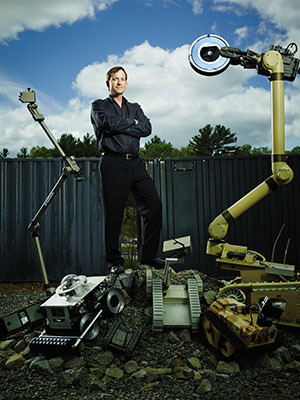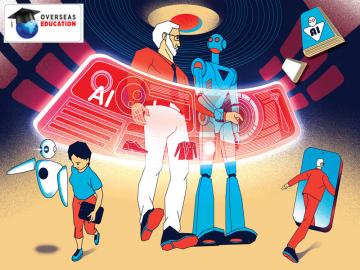
How iRobot is Invading Your Life
The end of iRobot’s military boom focussed it on figuring out how to make money off civilians
As he mashes the joystick controls, Colin Angle grins like a six-year-old boy playing with his first radio-controlled car, freshly torn wrapping paper thrown aside. But the 45-year-old iRobot co-founder and CEO isn’t testing out a toy—he’s putting a $100,000-plus piece of machinery to work, a remote-controlled 60-pound minitank with four cameras, rubber treads and a six-foot extendable arm.
Despite more than 25 years of robotics experience, Angle is still enchanted by the high-pitched squeal where the robot meets the road. But as he puts down the PackBot controller, his voice turns serious: “Every single EOD [explosive ordinance detonation] technician I’ve interviewed has started off saying, ‘Thank you, I’d be dead without your robot.’” The 4,000 iRobot PackBots in service have saved countless lives hunting IEDs (inprovised explosive devices) in Afghanistan and Iraq—and more recently at home, where iRobot’s fleet was deployed during the Boston Marathon bombings manhunt (less than 30 minutes away from the company’s headquarters in Bedford, Massachusetts).
They also saved millions of carpets in America from dirt and dust bunnies. Profit from military robots subsidised the company’s most well-known product, the eccentric autonomous home vacuum cleaner known as the Roomba. In 2011, defence contracts accounted for 40 percent ($187 million) of the company’s revenue. However, with US forces pulling out of Iraq and Afghanistan and budgets slashed across the board, government funding has dried up—iRobot lost 57 percent of its defence revenue in 2012 and projects another drop over 30 percent in 2013.
Yet Angle has managed to pull off a remarkable transition to peacetime robotics. While 124 people were laid off over the last two years and overall revenue dipped 6 percent in 2012 to $436 million, consumer sales grew at a 28 percent clip, and Wall Street loved the results from the first three months of 2013, when iRobot raised its projected full-year Ebitda to $55 million, more than double that of 2012. If Angle can maintain growth like that, he has a chance to fulfill his longtime dream: Bringing robotics from the realm of science fiction to the reality of home chores and health care. Supported by the Roomba’s rapid growth, iRobot has invested millions of dollars to develop its big new thing: The RP-VITA, the first remote-presence robot approved for use in hospitals.
Founded in 1990 by Angle, fellow MIT grad Helen Greiner and MIT professor Rodney Brooks, the company was initially more of a nerd dream than a workable business plan. An early product idea was to take Angle’s master’s thesis, a six-legged insectoid robot, and send a variation of it with a camera to the moon, then sell the movie rights. As Angle says, “We were the first company to fail at that.” (That robot now sits at the Smithsonian National Air & Space Museum.)
Instead, iRobot went into business with multinationals. It built a robot for Baker Hughes and Halliburton that could operate in active oil wells, a facial expression mechanism for Hasbro’s My Real Baby doll and floor-cleaning machines for Johnson Wax. None of these endeavours was particularly profitable, but afterwards, Angle says, iRobot was “in the unusual position where we knew robotic technology, low-cost manufacturing and how to clean”. Out of that combination came iRobot’s first commercial hit, Roomba, which makes up the majority of its 9 million consumer robots sold worldwide.
Just a few inches high, the Frisbee-size Roomba rolls drunkenly across your floor, bumping into walls and chairs seemingly at random. Of course, there’s intelligence at work. The Roomba knows where it has already cleaned, adjusts vacuuming technique based on particles it encounters, and even detects and avoids stairs. When the device first launched in 2002, Angle brought a box of Cheerios to retailer pitch meetings. Smashing cereal into the office carpet, he would unleash the Roomba on the mess.
But as Angle now says, “Just because you have the technology doesn’t mean you have a business.” Roomba’s gross margins of under 30 percent weren’t enough to make the endeavour profitable. iRobot went public in November 2005 despite losing $7 million on revenue of $43 million in the first six months of that year. Without the military contracts for recon robots, iRobot might not have survived.
The problem, says COO Jeff Beck, who came to iRobot in 2009 from the aerospace and defence side of Ametek, was that the merchandising strategy didn’t match the product. “The DNA of the organisation was all about unit volume,” Beck says. “How many pallets can we shove into Costco and how fast can they move out?” The Roomba is a highly differentiated vacuum, the only one that many owners personify with a name—but it was on shelves next to traditional upright models. iRobot sold essentially the same version in different colours to every chain, which only encouraged them to discount heavily.
No longer. iRobot cut off one big chain that refused to switch to more prominent, specialised displays. It attacked overseas markets like Japan, where a ‘barefoot clean’ culture fit has made it the company’s second- largest market, and invested $10 million in a new US ad campaign to combat scepticism about the Roomba. Perhaps most important, iRobot added new models at higher prices with features like a HEPA filter, scheduling and room-by-room navigation. Gross margins have grown to more than 45 percent.
iRobot’s consumer division, which also includes the floor-scrubbing Scooba, pool-cleansing Mirra and gutter-busting Looj, now make up 90 percent of revenue, up from 60 percent two years ago. And instead of a drag on the bottom line, Roomba has subsidised the development of what Angle hopes is the next big step for iRobot: Health care.
The RP-VITA, a five-foot remote-presence robot that doctors control with an iPad from miles away, is already deploying to six hospitals in the US and one in Mexico in partnership with telemedicine company InTouch Health. Building on technology used in the Roomba, the RP-VITA can travel autonomously to a specific room or even follow a patient, rerouting based on obstacles. Doctors can communicate face-to-face with patients, making diagnoses via web cam, and can even use an attached stethoscope.
The whole system, including support, runs on $5,000 a month. As bigger players like Samsung and LG improve their own autonomous vacuum cleaner offerings, iRobot’s long-term success will depend on diversification into new markets like this one.
And that fits fine with Angle’s vision of the future, in which advanced robotics take over more functions between the extremes of cleaning floors and busting bombs. “It’s going to be interesting to see how society deals with artificial intelligence,” he says, flashing another puckish grin. “But it will definitely be cool.”
(This story appears in the 28 June, 2013 issue of Forbes India. To visit our Archives, click here.)
-
 Vibhu Ashok
Vibhu AshokTitle of this article got my attention, then as I went through the details, it got more interesting. I think Angle is trying to make change, in a way his devices makes us more independent of Servants. so in near Future one or more of his products are going to be present in 80% of homes. Waiting for it to happen in India. if priced in right price bracket, India will be the most beneficial market for IROBTS.
on Jun 15, 2014















